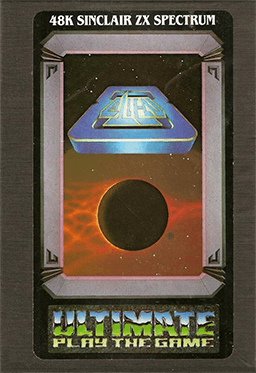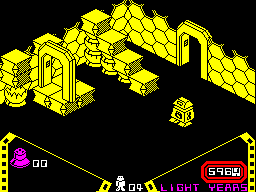Alien 8
| Alien 8 | |
|---|---|
 | |
| Developer(s) | Tim and Chris Stamper |
| Publisher(s) | Ultimate Play The Game |
| Engine | Filmation |
| Platform(s) | ZX Spectrum BBC Micro Amstrad CPC MSX |
| Release date(s) | 1985 (Spectrum) November/December 1985 (MSX)[1] |
| Genre(s) | Arcade adventure; Maze |
| Mode(s) | Single player |
| Distribution | Cassette (Spectrum, BBC, Amstrad, MSX) Cartridge (MSX) |
Alien 8 is a ZX Spectrum video game. It was written by Tim Stamper and Chris Stamper of Ultimate Play The Game, and was released by the company in 1985. The game was also ported to the BBC Micro, Amstrad CPC and MSX platforms. It is the follow-up to Ultimate's Knight Lore, which had been released in 1984. As with its predecessor, Alien 8 is a platform game rendered in then-novel isometric projection.[2] In the game, the player takes control of a robot, Alien 8, whose job is to ensure that all of the cryogenically frozen passengers on a spaceship remain viable during the ship's voyage.
Plot
On a dying planet in a distant galaxy, the last of the guardians store all of their libraries, records, and knowledge on a single starship together with cryogenically preserved members of their race. A single robot, "Alien 8" is tasked with keeping these people alive.
The ship is launched towards a new solar system and Alien 8 performs his task for thousands of years during the journey. However, as the ship nears its destination, it is attacked and boarded. The cryogenic life support systems are damaged and Alien 8 must restore them to operation before the ship's automatic thrusting systems manoeuvre the ship into planetary orbit.
Gameplay

Taking on the role of the "cybot" Alien 8, the player must explore a large starship in order to ensure that the cryogenic life support system preserving the biological crew is kept activated. The core of this system is a series of geometrically-shaped circuits. These have been removed by invading aliens, and distributed around the starship. By collecting these circuits and returning them to their proper locations before the starship reaches its destination, Alien 8 will successfully satisfy its programming. Failure results in a humorous cutscene showing violent reprogramming.
In Knight Lore, the player must return the objects to a single central location. In Alien 8, there are many cryogenic suspension rooms, and only a few types of circuit (e.g. cube, pyramid, dome), which means that the gameplay is less linear.

As with Knight Lore, the environment of Alien 8 takes the form of a series of isometric flip-screen rooms (which trace the outline of a large starship). These are filled with platforms (including some that move), moveable objects, static hazards and dangerous aliens. The latter take the form of strange, sparkling life-forms (similar to Knight Lore), mouse-Dalek hybrids and mindless, but fast-moving, clockwork mice. As well as executing well-timed manoeuvres and jumps, inventive players can use starship props to block or defend themselves. Another feature is the use of remote controlled drones, which can be directed by Alien 8 into inaccessible or dangerous areas.
References
- ↑ Knight Lore, Alien 8 and Nightshade MSX pre-release promotional brochure, published by Ultimate Play The Game in October 1985. Available to view at World of Spectrum:
- ↑ "Looking For An Old Angle". Crash Magazine, Issue 51. Newsfield. Archived from the original on 24 September 2006. Retrieved 2006-10-03.
External links
- Alien 8 at Ultimate Wurlde
- Alien 8 at World of Spectrum
- Alien 8 at MobyGames
- Alien 8 review at CRASH magazine
- A walkthrough video of Alien 8 on the ZX Spectrum at Google Videos
| ||||||||||||||||||||||||||||||